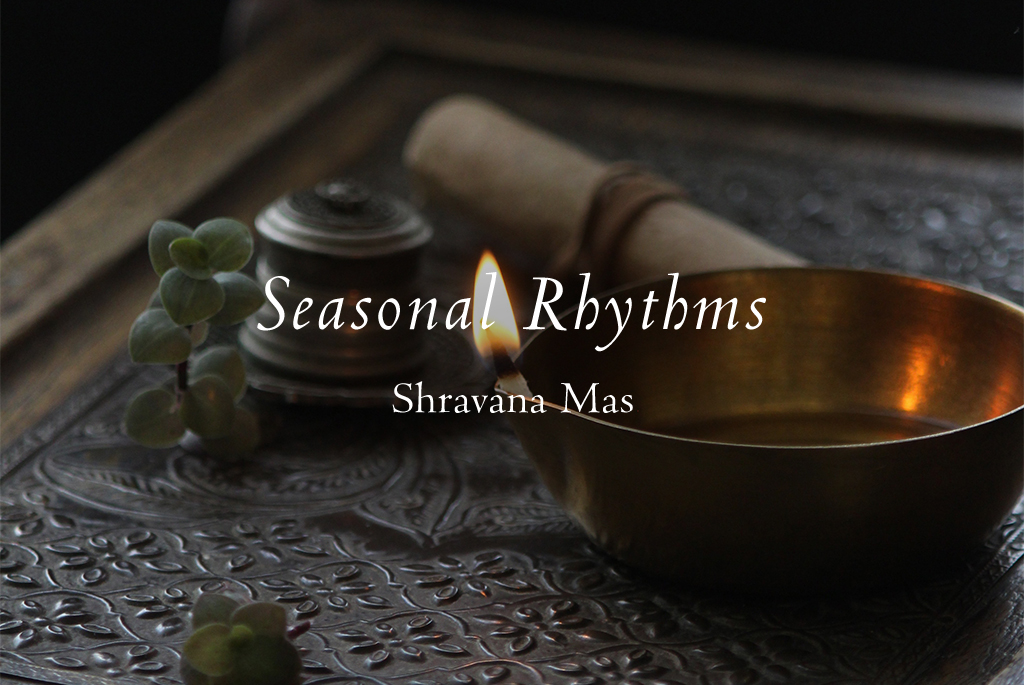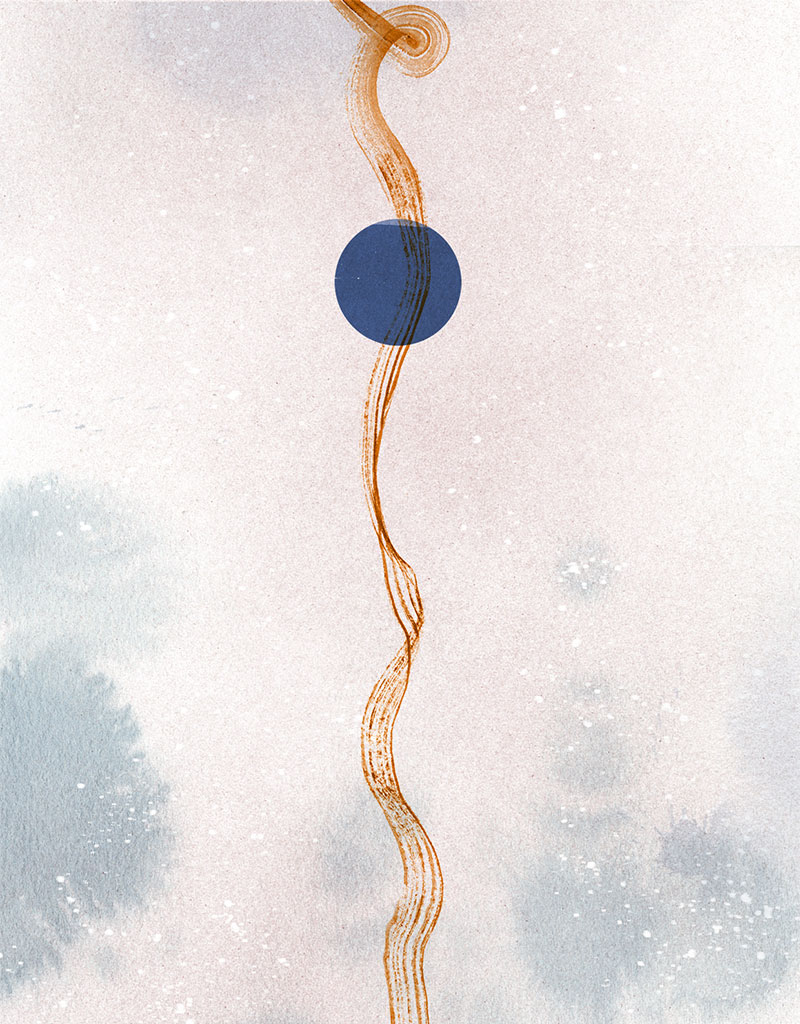Nilakshi Sharma

Then, the stormy monsoon-wind blew, making the forests shake; clouds rose up, filling the sky.
As if torn asunder, the bright clouds with their thunder released pure water, satiating the growing crops…
(the clouds) which obstruct the sun, dwell in parts of the sky, adorning (it), wandering about and shining their lightning.
Shravana mas ushers in that most eagerly awaited and dramatic of seasons – Varsha rtu.
The intense, blistering heat of Grishma rtu makes the very earth itself long for the arrival of the season of rains; the parched earth waits for the life-giving rains like a lover awaiting the arrival of her lover.
These three aspects of the season – its dramatic beauty; the longed for union between the earth and the sky and the impact of the season of the water on landscape and agriculture are what makes Varsha rtu arguably the most important of all seasons.
Dramatic Skies
In Vedic literature the two months of monsoon – Shravana and Bhadrapada were called “Nabhas and Nabhasya” meaning mist, clouds or sky. These are the two months of dramatically beautiful skies. Storm tossed dark clouds lit with lightning and thunder, dark clouds swollen with water that roll over the horizon, bringing with them dancing, moisture laden breezes and the mercurial changes that can change the skies from the softest of pearlescent greys to dramatic indigo… in this season the sky becomes the canvas on which the clouds display all of their mercurial moods and beauty. Monsoon, the season of skies is also the season of light – after the blinding glare of the Sun in Grishma rtu, in monsoon the light is a refracted delight of blue and grey tones, shot through with the dazzling gold of sunlight when the Sun occasionally breaks through the rain clouds.
As Red Earth And Pouring Rain
“What could be my mother be
to yours? What kin is my father
to yours anyway? And how
did you and I meet ever?
But in love our hearts are as red
earth and pouring rain:
mingled
beyond parting.”
Trans. AK Ramanujan
Monsoon offers the most powerful metaphor for union. The season has long been celebrated in the subcontinent as the time of erotic unions – with the most famous simile found in a classical Tamil poem from the Kurunthogai Anthology of Sangam Literature, dated to be at least 2000 years old. The author is referred to as Sempulapeyaneerar, literally ‘he of water that has rained on red fields’. Like the earth’s longed for union with the sky through the waters of the season, all living beings are drawn to mate with their beloved in this season. Monsoon then becomes the literal and figurative season and symbol of both fertility and fecundity in the subcontinent. Vegetation becomes verdant and its growth is palpable.
Season of Poetry
“Having seen the Kutaja flowers full of intoxicated bees on the ground near the hill, and having seen the sky with its clouds full of water, the peacocks emitted loud cries, similar to the notes of a song.”
Desire and its fulfilment is the characteristic trope of the season that seeps into and saturates every description, experience and impact of these two months. And thus, the monsoon itself becomes the trope of desire in all of the subcontinent’s artistic expressions – art, poetry, dance, music, literature and even the design vocabulary.
In the subcontinent, the monsoon has been the muse for all of our recorded history across art forms and even in mythology.
From the dance of the peacocks to the erotic description of Shiva and Parvati’s union; from celebrating the beauty of white cranes against dark storm clouds as a dramatic ode of opposites to the clouds becoming messengers of love and longing in Kalidasa’s ‘Meghaduttam’; from the indescribable allure of Raga Megha Malhar in countless renditions and variations to the miniatures depicting nayikas (women) braving the darkness and thunderstorms to meet with their beloved; from frolicking elephants drunk on the scent of monsoons to lovers intoxicated by the presence of their beloved… Varsha rtu permeates all our descriptions and depictions of love and longing and offers the erotic delight of a longed for consummation.
Self Care & Shravana
The month of Shravana offers a deeply longed for reprieve from the blistering, scorching intense heat of Grishma rtu. The time of water begins as a time of delight – rehydrating our senses and bodies. Slowly the water element strengthens and then becomes dominant in this month. Traditionally the arrival of the lunar month of Shravana is accompanied by the start of Dakshinayana – the second half of the solar year, on July 16. Unlike the first half of the solar year (Uttarayana), which is characterised as the time of the Sun, Dakshinayana is seen as the time of the water, when slowly, over the course of six months, lunar energy becomes dominant.
Monsoon and the start of Dakshinayana both have an impact on our digestive Agni. In Ayurveda, the longed for season of rains is also seen as the time of a weakened digestive capacity. Thus, all three doshas – Pitta, Vata and Kapha can become vitiated during this season. To align our bodies with the season and build the immunity that Dakshinayana (solar half of the year) encourages, we need to nurture our bodies during the two months of Shravana and Bhadrapada. Since our digestion capacity weakens, it is important to eat foods that support rather than overload our digestive system. Here are some simple and traditional ways to support our digestive Agni and nurture our bodies in this month:
- Tridoshic Diet: Try to eat foods that have a balancing effect for all three of our body doshas. Khichari cooked in desi Ghee is the perfect example of food that balances all three. A tridoshic tisane - CCF tea, can be consumed once a day to strengthen the digestive fire, increase the elimination of waste and improve gut health, decrease bloating, acidity and flatulence, and help with inflammation.
To make CCF or Coriander, Cumin & Fennel Tea: Combine a teaspoon each of Coriander, Cumin and Fennel seeds in a saucepan. Add 2 cups of water, cover and simmer on a low flame till the quantity of water reduces to half. Strain and drink the tea.
Apart from tridoshic foods choose warm, lightly cooked, easy to digest meals. Grains like Rice and Barley are recommended. Avoid raw leafy vegetables, nuts, etc., which are heavy and require digestive effort.
- Honey: The regular consumption of small amounts of Honey is also traditionally recommended during the monsoon season.
- Tastes: Sour, salty and sweet are the three tastes that are recommended in this month. Foods with a sour taste such as the fruit Amla offer the elements of Earth and Fire, while a salty taste offers the elements of Water and Fire. A sweet taste combines the elements of Earth and Water. Foods that have an unctuous quality are also recommended. As per many experts Cow Ghee is the best to consume in this category of unctuous foods.
- Supporting Agni: A cup of Ginger tea – a teaspoon of freshly grated Ginger steeped in hot water, before a meal like lunch can help to gently stimulate digestion, thereby strengthening our digestive fire.
Festive Rituals of Shravana
The two months of Shravana and Bhadrapada are considered sacred and dedicated to Shiva and Parvati in the Sanatan tradition. Mondays are considered especially sacred as they are dedicated to Shiva, thus many devotees fast on Mondays during these two months.
But the most colourful celebrations dedicated to both Shiva and Parvati are the three Teej celebrations in this season. In each of them Shiva represents Purusha, the masculine principle and Parvati represents Prakriti which is both the feminine principle as well the fecund nature which nurtures creation and nourishes it with her abundance. The first of these, Hariyali Teej celebrates the marriage and union of Shiva and Parvati. With its emphasis on the colour green, it is a celebration of fertility and fecundity. This year Hariyali Teej falls on August 7.
Exactly two days later, August 9 will be celebrated as Naga Panchami. On this day traditionally snakes (naga) are worshipped and their idols and real snakes (in the case of certain communities) are propitiated with milk and greeted with prayers. Traditionally, the twelve snakes of Hindu mythology are worshipped – Ananta, Vasuki, Shesha, Padma, Kadambala, Karkotaka, Ashvatara, Dhritarashtra, Shankhapala, Kaliya, Takshaka and Pingala. The traditional Naga Panchami mantra is:
सर्वे नागाः प्रीयन्तां मे ये केचित् पृथ्वीतले।
ये च हेलिमरीचिस्था येऽन्तरे दिवि संस्थिताः॥
ये नदीषु महानागा ये सरस्वतिगामिनः।
ये च वापीतडगेषु तेषु सर्वेषु वै नमः॥
This translates as “may the snakes who are staying in this world, sky, heaven, sun-rays, lakes, wells, ponds etc., bless us and we all salute them.”
Shravana mas will come to a close with two beautifully different festivals on Shravana Purnima – August 19. The first is the widely celebrated bond between brothers and sisters – Raksha Bandhan. The second is a festival that is older by far, and today celebrated primarily by the sea faring, coastal communities of Maharashtra.
On this day, in a ritual that clearly goes back to the Vedic era, they invoke the energy of Varun and seek his blessings. Varun, a deity of forgotten significance today, was once counted amongst the most powerful of gods. To him, the god of all waters, the fisher folk celebrating this festival offer coconuts. And ask for protection for when they are out on sea and a bountiful catch for the year. And to acknowledge the abundant offering of the earth and the sea they plant a tree as a part of the festive rituals.
May we all acknowledge the dominion of the water god, Varun and plant a tree to honour the earth on Nariyal Purnima this year.





